The best wood for smoking ribs depends on whether you are planning to smoke pork ribs or beef ribs since they have different flavor profiles. Beef has an audacious taste and is elevated by bold flavor woods like hickory and mesquite.
Pork is more delicate than beef and is better suited to a lighter flavor like pecan wood or fruitwood.
I come from a long line of barbecue warriors so I have sampled every meat smoked on our aged smoker over the years. Every wood flavor has unique characteristics that are appreciated and celebrated by different palettes, so the best wood for smoking ribs is simply one that you enjoy.
This article is the only guide you need to understand the different types of wood flavors and wood sizes available to smoke ribs and their characteristics. Let’s dive in:
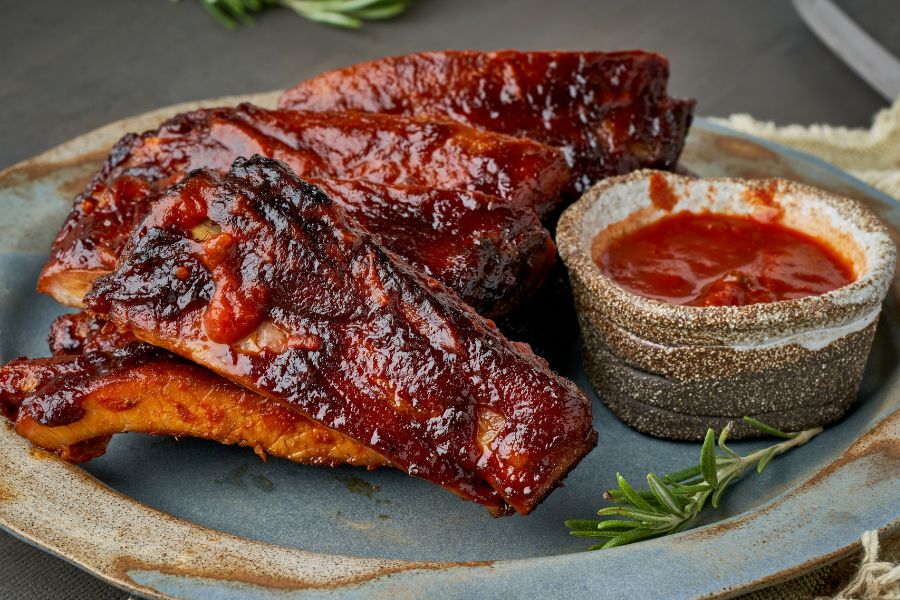
Whether you plan on smoking pork or beef ribs, you will want to pick a wood flavor that marries with your meat as opposed to one that will smother it.
Pork ribs have a milder flavor compared to beef and can easily be overwhelmed by strong wood. It responds better to sweet, tart notes.
Beef has an intense flavor that can be elevated by strong flavors.
You can also try a mix of strong and subtle flavors. Cherry or apple mixed with mesquite or hickory is a perfect blend of intensity.
Hickory and pecan woods combined give the meat a nutty taste and a mild sweetness.
In my opinion, a blend of oak and cherry wood is the best wood for smoking pork ribs. Cherry’s sweet notes and pork’s savory taste are a match made in barbecue heaven.
Oak serves as a great substitute for hickory wood since hickory can be overpowering on pork ribs.
With a mix of cherry and oak wood, you get the best of both worlds: a strong smoke flavor, a deep brown color, and the fruity flavor of cherry on smoked pork ribs. You can also swap out cherry wood with apple for similar results.
If you would like to add a nutty surprise to your spare or baby back ribs without having to use hickory, use a mix of pecan wood and cherry.
I’ve also had great success with a blend of pecan and apple wood for smoked baby back ribs served with apple butter sauce. Try it.
Beef has a bold flavor and is complemented by other strong flavors like garlic, red wine, and soy sauce, among others. When it comes to smoking beef ribs, hickory wood is popularly used as a base and mixed with another wood flavor.
Hickory wood is my go-to for beef ribs because I like to take advantage of the strong nutty taste and bacon-like flavor.
Hickory is a dense wood that gives off a lot of heavy smoke which fixes a mahogany brown color on smoked beef ribs making them irresistible.
Both hickory and mesquite are heavyweights when it comes to bold, unapologetic flavors. They are widely adored in the smoking arena but at the same time, a lot of people find them a bit too much.
If you don’t care for the assertive taste and aroma of hickory and mesquite, why not try oak for your beef ribs?
Oak is one of the oldest woods for smoking ribs. It has a stronger flavor than all fruit woods but is lighter than both hickory and mesquite making it a good substitute.
Oak can withstand very high temperatures and burns for a long time. These qualities make it a good choice for different styles of smoking ribs since you can cook low and slow or crank the heat up.
Pecan is also a milder option for hickory because they are related. That said, beef ribs respond well to different combinations of wood flavors.
You can add cherry or apple wood to oak to add a fruity taste to your beef ribs. Cherry is commonly mixed with oak, pecan, or hickory to fix its red color on ribs.
If you are still in doubt about which wood flavor to use or you want to compare notes with the greats, check out what these professional pitmasters use to smoke their ribs.
Myron Mixon, a celebrity chef with 5 BBQ championships under his belt stands by peach wood for baby back and spare ribs for its light essence.
Aaron Franklin, a host on the cooking show BBQ with Franklin and an influential pitmaster prefers beef plate ribs smoked with post oak or hickory.
Melissa Cookston who has won the world BBQ championship 7 times over and author of two cookbooks use apple and cherry for baby back ribs.
Now that you know the best smoking wood for your ribs, let’s look into the size you should get. The different wood sizes available are logs, wood chunks, wood chips, wood pellets, or sawdust.
Which one you use depends heavily on the cooking gear. If you have a pellet grill like me, most manufacturers recommend using wood pellets.
Logs are great when you have a lot of working space. If you want to use your barbecue pit, go for a log or wood chunks. You can also use both.
Charcoal grills give the best results when you use coal but you can add in some wood chunks or pellets for flavor.
If you are smoking on a Kamado grill, use wood chunks or pellets alongside coal to smoke meat.
Logs are huge bulky pieces of a fallen tree. They are great for smoking ribs on a barbecue pit, a chimney, or a large offset smoker.
I don’t recommend using logs to smoke ribs because smoking a rack of ribs takes a short time. The log might be overkill.
On the other hand, if you want to barbecue brisket from a wild bison low and slow on a campfire, logs are a good way to go.
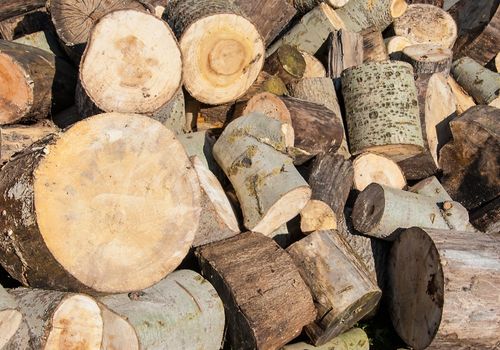
Wood chunks are smaller than logs but are large too. They burn for a long and you will not have to keep refilling your smoker. Each time you open your smoker while your meat is cooking, you lose precious heat and smoke.
Wood chunks will comfortably fit in charcoal grills and a lot of smokers.
Add wood chunks to lit coals for a charcoal grill and let the grill do the work.
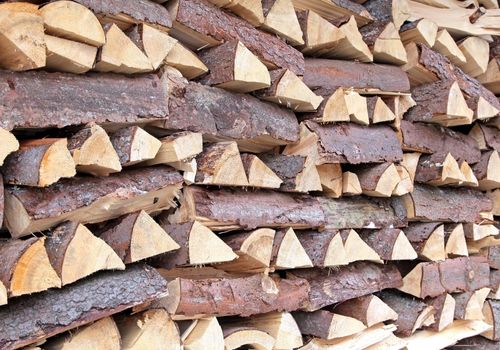
Wood chips are much smaller than wood chunks. They are normally made from the leftover material used in the manufacture of large hardwood products like furniture.
Your electric smoker will have a smoker box fixed below the heating element where you can place your wood chips.
You can also use wood chips in your gas or charcoal grill by wrapping them in heavy-duty aluminum foil and puncturing a few holes with a knife or a fork. Place the foil over the fire to release the flavor of the wood.
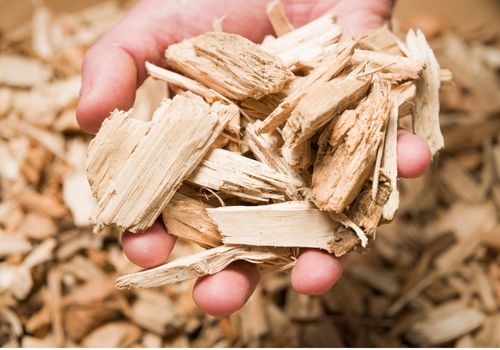
Wood pellets are made by draining all the moisture content from wood fibers before being thoroughly ground into dust. This dust is then compressed to form wood pellets.
There are a lot of pellet grill brands to choose from. As for me and my Traeger Pro, it has always been love at first sight. You can also use wood pellets on a gas or charcoal grill to add a smoky flavor to your barbecue.
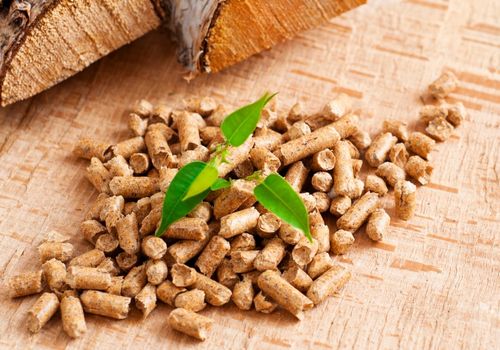
This is dry powder-like wood and it burns quickly. It gives off less heat than wood chips and pellets, so it must be refilled often.
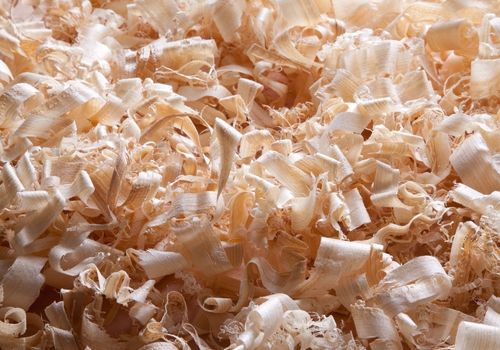
First, we have softwoods and hardwoods. The difference is not in their name but in their characteristics. Yew wood is normally classified as softwood despite it being tougher than many hardwoods. Similarly, balsa wood is classified as hardwood yet it is one of the softest woods.
Hardwood comes from flowering plants, also called angiosperms while softwood comes from non-flowering plants, also known as gymnosperms.
Softwoods like cider and pine are not safe for smoking. They can be hazardous since they ooze a lot of resin which can cause flare-ups.
Hardwoods like pecan, hickory, and mesquite add intense flavors to meat. They burn hotter, slower, and longer than softwoods. Hardwoods are available in several flavors and forms.
Lastly, we have fruitwood. Fruit woods are technically hardwoods. They come from trees that bear fruit. The most common fruit woods include cherry, maple, and apple wood.
Different flavors of smoking wood can be described as either mild wood or strong wood. The right wood to use depends on the meal you want to prepare. You should go for a wood flavor that is closer to the taste of your meat.
If you want a smoking wood that will add a punchy flavor to your meat, consider these:
Mesquite wood is probably the most intense of the smoking woods. It adds a robust earthy flavor to the barbecue and produces very rich, spicy notes. Using too much mesquite could give your meat a bitter taste.
Mesquite burns hot and is prone to over-smoking. I recommend mixing mesquite with more polite wood flavors when smoking ribs.
Hickory has a very bold flavor that is stronger than fruit wood but not as intense as mesquite. It has a bacon-like taste and an intense smokey flavor. It also imparts a nutty flavor to smoked meat.
Hickory smoke fixes a mahogany color which is a barbecue signature and blends seamlessly with sweet and sour barbecue sauces.
When smoking with hickory, it is best to air on the side of caution. Too much hickory can easily overwhelm your smoked ribs and impart an unpleasant taste.
Oak is a versatile flavor that pairs well with many types of meat. It is potent without distinct flavors yet milder than both hickory and mesquite. If you want a meat rub or marinade to stand out, oak wood is the way to go.
It doesn’t produce too much smoke and it imparts a deep brown color to the meat that is familiar for smoked ribs.
Pecan wood is a species of hickory. It bridges the gap between strong flavor and mild flavor profiles. It is sweet, with a hint of nuttiness. Because of this unique flavor profile, it is the preferred wood for Southern-style ribs.
This is for folks that only want a hint of smoke flavor in their meats.
Applewood has a sweet and fruity flavor that pairs well with the savory notes of meat. It is commonly used on bacon and delicate meats like fish.
Smoking with it requires longer cooking times to impart its flavor on meat because it produces a very light smoke.
Cherry wood adds a subtle sweet flavor to the meat that is hard to miss. It also lends a reddish color to your ribs that serves to show off a good smoke ring.
Maple brings a mild sweetness to the meat without the fruit flavor. It produces very light smoke.
Peach wood has a slightly sweet flavor and mild smoke. It complements spicy sauces perfectly. It is highly prized because it is hard to find in most parts of the country.
Apple is a good wood flavor for smoking both beef and pork ribs if you fancy a fruity twist on your ribs. Bear in mind that because it produces light smoke, you have to smoke your ribs longer to fix the apple flavor and aroma.
Consider blending it with other types of wood like oak for pork ribs or hickory for beef ribs.
I use a mix of post oak and cherry wood chips by Western premium BBQ products for smoking baby back ribs and spare ribs. They can be used on a gas grill, a griddle, or an electric smoker.
The best woods for smoking ribs depend on your personal preference. Smoking is a craft that is perfected by trial and error. Don’t be afraid to experiment with different flavors until you find a blend that melts your heart.